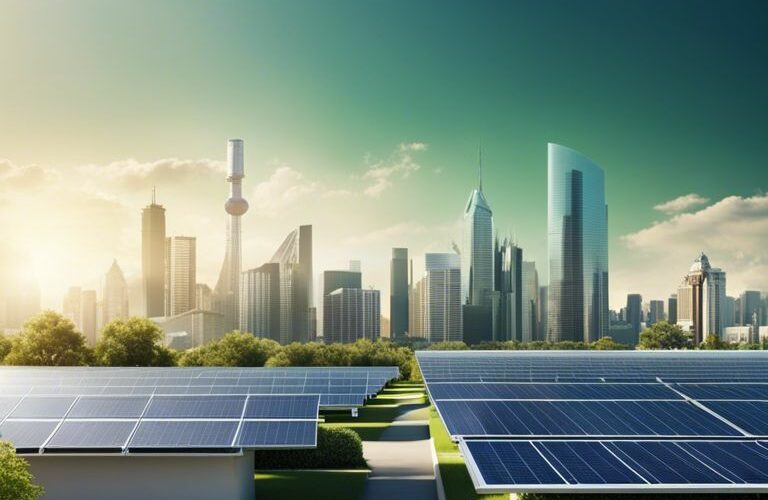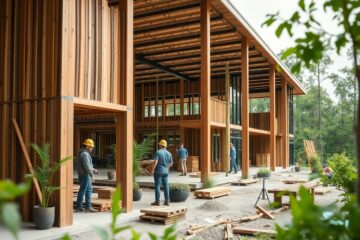Oftentimes, when discussing the importance of energy efficiency in buildings, the focus tends to lean heavily on its positive impact on the environment. While this is undeniably crucial, it is also crucial to highlight the significant economic benefits that come hand in hand with implementing energy-efficient practices in buildings. Not only does energy efficiency contribute to a healthier planet by reducing greenhouse gas emissions and overall energy consumption, but it also offers strong financial advantages for building owners and occupants.
Table of Contents
Key Takeaways:
- Energy Efficiency Reduces Costs: Improving energy efficiency in buildings can lead to significant cost savings for owners through lower energy bills.
- Increased Property Value: Buildings with high energy efficiency ratings tend to have higher property values, making them more attractive to potential buyers or tenants.
- Environmental Benefits: Energy-efficient buildings reduce greenhouse gas emissions and help combat climate change, contributing to a healthier planet.
- Healthier Indoor Environment: Energy-efficient buildings often have better indoor air quality, leading to improved health and productivity for occupants.
- Government Incentives: Many governments offer incentives, rebates, and tax breaks to encourage building owners to invest in energy-efficient upgrades, making it a win-win situation for all stakeholders.
The Economic Advantages of Energy-Efficient Buildings
Obviously, there are numerous economic benefits associated with investing in energy-efficient buildings. These benefits not only contribute to cost savings for building owners but also have a positive impact on the environment by reducing energy consumption and greenhouse gas emissions.
Reduction in Operating Costs
Operating an energy-efficient building can result in significant cost savings due to lower energy consumption. By incorporating energy-efficient features such as LED lighting, programmable thermostats, and high-efficiency HVAC systems, building owners can dramatically reduce their utility bills. Moreover, energy-efficient buildings require less maintenance and replacement of equipment, further lowering operating expenses over time.
Additionally, energy-efficient buildings tend to have longer equipment lifespans and lower downtime, leading to increased productivity and tenant satisfaction. By investing in energy efficiency, building owners can maximize their return on investment and improve the overall financial performance of their properties.
Enhanced Property Values
Economic studies have consistently shown that energy-efficient buildings command higher property values in the real estate market. Properties with green certifications or high energy efficiency ratings tend to attract premium pricing and sell at a faster rate than conventional buildings. This is due to the perceived long-term cost savings associated with energy-efficient features and the growing demand for sustainable buildings among investors and tenants.
Energy-efficient buildings also tend to have higher occupancy rates and lower tenant turnover, further boosting property values and rental income. Building owners who prioritize energy efficiency not only benefit from reduced operating costs but also enjoy competitive advantages in the market and increased asset value over time.
Attraction and Retention of Tenants
Property owners and managers can leverage energy efficiency as a strategic marketing tool to attract and retain tenants. In today’s competitive real estate landscape, tenants are increasingly seeking sustainable and energy-efficient properties that offer a healthy and comfortable indoor environment. By promoting the energy efficiency of a building, owners can appeal to environmentally conscious tenants and differentiate their properties in the market.
To maximize tenant satisfaction and retention, property owners can implement energy-efficient practices such as waste reduction, water conservation, and indoor air quality improvements. By creating a sustainable and energy-efficient living or working environment, owners can cultivate long-term relationships with tenants and enhance the overall value proposition of their properties.
Access to Incentives and Rebates
Property owners who invest in energy-efficient upgrades may qualify for a variety of financial incentives and rebates offered by government agencies, utility companies, and other organizations. These incentives can help offset the upfront costs of energy-efficient improvements and accelerate the payback period for building owners. For instance, owners of commercial buildings that achieve energy efficiency certifications such as LEED or Energy Star may be eligible for tax incentives or grants to support their sustainability efforts.
Energy Efficiency and Its Impact on Utility Infrastructure
Decreased Demand on the Power Grid
Energy efficiency measures in buildings lead to a decreased demand on the power grid. By optimizing energy consumption through efficient lighting, heating, cooling, and insulation, buildings can reduce their overall reliance on electricity from the grid. This reduction in demand during peak hours can help prevent blackouts and reduce the need for expensive upgrades to the existing infrastructure.
Implementing energy-efficient technologies such as smart thermostats and energy-saving appliances not only benefits the individual building owners but also has a positive impact on the overall stability and reliability of the power grid. It promotes a more sustainable energy system while lowering the risk of grid overload and associated financial costs.
Long-Term Savings for Utility Companies
Demand for electricity often peaks during hot summer months or cold winter days, putting stress on utility companies to meet the increased need for power. Energy-efficient buildings help flatten these demand peaks by consuming less energy overall, which can lead to long-term cost savings for utility companies by reducing the necessity for additional power generation or infrastructure upgrades.
Utility companies can benefit from lower operational costs and increased reliability when customers adopt energy-efficient practices. By incentivizing energy efficiency through rebates and incentive programs, utility companies can encourage customers to reduce their energy consumption, ultimately leading to a more sustainable and resilient energy grid.
Utility companies are increasingly recognizing the value of promoting energy efficiency among their customers. By investing in energy-saving initiatives and partnering with building owners to implement energy-efficient measures, utility companies can create a mutually beneficial relationship that leads to reduced strain on the grid and lower overall operational costs.
Contributions to Energy Independence
Infrastructure that supports energy-efficient buildings plays a crucial role in advancing energy independence. By reducing the reliance on traditional energy sources and promoting the use of renewable energy alternatives, energy-efficient buildings contribute to a more diverse and sustainable energy portfolio. This diversification is essential for enhancing energy security and resilience in the face of external disruptions.
Companies that prioritize energy efficiency in their buildings not only benefit from cost savings and environmental impact but also contribute to the larger goal of achieving energy independence. By investing in energy-efficient technologies and adopting sustainable practices, businesses can play a significant role in shaping a more resilient and sustainable energy future for all.
Environmental Implications of Building Energy Consumption
Despite the many benefits of energy consumption in buildings, it is essential to consider the environmental implications. Buildings are significant contributors to greenhouse gas emissions, affecting climate change. Energy-efficient buildings play a crucial role in mitigating these environmental impacts, making them an essential part of sustainable development.
Greenhouse Gas Emissions and Climate Change
Greenhouse gas emissions from buildings result from the energy used for heating, cooling, lighting, and operating appliances. These emissions trap heat in the atmosphere, leading to global warming and climate change. By reducing energy consumption through energy-efficient measures, building owners can significantly lower their carbon footprint and contribute to a healthier planet for future generations.
Implementing energy-efficient practices such as proper insulation, high-efficiency HVAC systems, and energy-efficient lighting can reduce greenhouse gas emissions and help combat climate change. Building codes and standards play a significant role in promoting energy efficiency in buildings, setting guidelines for sustainable construction and operation.
Local Air Quality and Public Health
To ensure good local air quality and protect public health, it is crucial to address the impacts of building energy consumption. Energy production and consumption in buildings can lead to air pollution, exacerbating respiratory illnesses and other health conditions. By improving energy efficiency and reducing emissions, building owners can help create healthier indoor and outdoor environments for occupants and communities.
It is essential to consider the sources of energy for buildings, as energy generation from fossil fuels can have significant negative impacts on local air quality. Transitioning to renewable energy sources such as solar or wind power can reduce air pollution and improve public health outcomes in the surrounding areas.
Sustainable Resource Management
Climate change is closely linked to sustainable resource management in buildings. Energy-efficient buildings not only reduce greenhouse gas emissions but also promote the efficient use of resources such as water, materials, and land. Sustainable building practices help minimize environmental impact and support the long-term health of our planet.
Change
By incorporating sustainable resource management strategies into building design and operation, owners can achieve significant cost savings and environmental benefits. From using recycled materials to implementing water-saving technologies, sustainable practices in buildings play a vital role in creating a more resilient and environmentally conscious built environment.
Technological Innovations in Energy Efficiency
Smart Building Technologies
To achieve greater energy efficiency in buildings, smart building technologies have emerged as a game-changer. These innovative systems utilize sensors, IoT (Internet of Things) devices, and automation to monitor and optimize energy usage in real-time. Smart thermostats, lighting controls, and occupancy sensors are just a few examples of how these technologies can significantly reduce energy waste while enhancing occupants’ comfort and productivity.
By collecting and analyzing data on building performance, smart building technologies can identify areas for improvement and adjust settings accordingly. This proactive approach not only leads to energy savings of up to 30% but also extends the lifespan of equipment and reduces maintenance costs in the long run.
Advances in Insulation and Building Materials
Materials play a crucial role in the energy efficiency of buildings. Advances in insulation and building materials have revolutionized the way structures are designed and constructed. Innovations such as aerogel insulation, phase-change materials, and cool roofs offer superior thermal performance, reducing heating and cooling loads significantly.
With an increased focus on sustainability, materials that are eco-friendly, recyclable, and energy-efficient are becoming the norm in the construction industry. Investing in high-quality building materials not only enhances energy efficiency but also improves indoor air quality and occupant health.
Technologies like Building Information Modeling (BIM) allow architects and engineers to simulate the energy performance of a building before construction begins. This predictive analysis helps optimize the design and selection of materials for maximum energy efficiency, reducing the environmental impact of the building over its lifecycle.
Renewable Energy Integration
An essential aspect of achieving sustainable energy efficiency in buildings is the integration of renewable energy sources. Solar panels, wind turbines, and geothermal systems are increasingly being incorporated into building designs to offset traditional energy consumption.
By harnessing renewable energy sources, buildings can generate their electricity, reduce dependency on the grid, and lower carbon emissions. The adoption of renewable energy integration not only contributes to environmental conservation but also provides long-term cost savings for building owners.
Advances in energy storage technologies such as batteries further enhance the effectiveness of renewable energy integration by enabling buildings to store excess energy for later use, ensuring a reliable and sustainable power supply.
Policy and Regulation: Shaping the Future of Energy-Efficient Building Practices
Government Policies and Building Codes
Codes and regulations play a crucial role in driving the adoption of energy-efficient practices in building construction and renovation. Many governments around the world have recognized the importance of reducing energy consumption in buildings to mitigate climate change and improve overall energy security. As a result, they have implemented policies and building codes that set minimum energy performance standards for buildings. These standards often cover aspects such as insulation, lighting, heating, cooling, and ventilation systems.
Government initiatives can significantly influence the design and construction of buildings, encouraging owners and developers to prioritize energy efficiency. By enforcing strict building codes and offering incentives for energy-efficient upgrades, governments can accelerate the transition towards sustainable building practices and help reduce greenhouse gas emissions.
Global Initiatives and Standards
Future global initiatives and standards are being developed to harmonize energy performance requirements across borders and promote consistent practices worldwide. Organizations like the International Energy Agency (IEA) and the United Nations Environment Programme (UNEP) are leading efforts to establish global standards for energy efficiency in buildings. These initiatives aim to create a level playing field for manufacturers, designers, and builders, fostering innovation and driving market transformation towards more sustainable building solutions.
Standards such as the ISO 50001 Energy Management Standard and the Leadership in Energy and Environmental Design (LEED) certification are becoming increasingly recognized and adopted by countries and industries seeking to demonstrate their commitment to energy efficiency. Adhering to these global standards not only helps organizations reduce their environmental impact but also enhances their reputation and competitiveness in the market.
The Role of Non-Governmental Organizations
Role of non-governmental organizations (NGOs) in promoting energy efficiency in buildings cannot be overlooked. NGOs play a vital role in raising awareness, providing education and training, and advocating for policies that support sustainable building practices. Organizations like the World Green Building Council and the Alliance to Save Energy work closely with governments, businesses, and communities to drive the adoption of energy-efficient technologies and practices.
To create lasting change, NGOs collaborate with various stakeholders to develop resources, guidelines, and best practices for improving energy performance in buildings. By engaging with industry partners and policymakers, NGOs can help shape the regulatory environment and facilitate the widespread adoption of energy-efficient building practices, ultimately benefiting both the environment and building owners.
Case Studies: Success Stories of Energy-Efficient Buildings
Not all buildings are created equal when it comes to energy efficiency. Here are some examples of buildings that have successfully implemented energy-saving measures and reaped the benefits:
- Residential Building in San Francisco: This apartment complex reduced its energy consumption by 30% by installing energy-efficient appliances, LED lighting, and better insulation.
- Office Building in New York: By upgrading to a smart HVAC system and implementing occupancy sensors, this building cut its energy costs by 20% in just one year.
- Retail Store in Los Angeles: This store installed solar panels on its roof, which now generate 50% of the energy needed to power the building, saving them thousands of dollars annually.
Residential Building Examples
Stories of residential buildings implementing energy-efficient solutions showcase how small changes can lead to significant savings in energy costs and reduced carbon footprint. By investing in high-efficiency appliances, proper insulation, and renewable energy sources, homeowners can enjoy a comfortable living space while contributing to a more sustainable future.
Commercial Building Examples
Any commercial building looking to boost its bottom line and sustainability credentials can follow suit. By incorporating energy management systems, optimizing lighting and HVAC systems, and investing in renewable energy sources, businesses can see a substantial decrease in their utility bills and enhance their reputation as environmentally conscious entities.
Buildings that prioritize energy efficiency not only benefit financially but also contribute to a healthier environment by reducing greenhouse gas emissions and energy waste.
Industrial Building Examples
To showcase the impact of energy efficiency in industrial settings, companies have implemented measures like upgrading to energy-efficient machinery, implementing waste heat recovery systems, and optimizing production processes. These changes have not only resulted in significant cost savings but have also improved the overall operational efficiency and sustainability of the facilities.
Plus, industrial buildings that commit to energy efficiency demonstrate leadership in corporate social responsibility and pave the way for a more sustainable industrial sector.
Future Trends and Opportunities
The Role of Artificial Intelligence and Machine Learning
Intelligence: Unlike traditional energy management systems, the integration of Artificial Intelligence (AI) and Machine Learning (ML) in building operations is revolutionizing the way energy efficiency is achieved. These advanced technologies analyze vast amounts of data in real-time to optimize building performance and reduce energy waste. By learning patterns and predicting energy consumption, AI and ML systems can make adjustments automatically, without human intervention, leading to significant energy savings.
Intelligence: The role of AI and ML in energy efficiency is only expected to grow. As technology continues to advance, buildings will become smarter and more energy-efficient. From predictive maintenance to personalized occupant comfort settings, AI and ML offer a wide range of possibilities for improving energy performance in buildings. Implementing these technologies can result in not only cost savings for building owners but also reduced environmental impact.
New Business Models and Economic Opportunities
For: New business models in the energy efficiency sector are creating opportunities for both building owners and energy service providers. With the rise of performance-based contracts and energy savings guarantees, building owners can now implement energy efficiency measures with little to no upfront costs. This shift allows for a more widespread adoption of energy-efficient practices, driving down overall energy consumption and greenhouse gas emissions.
Opportunities: In addition, energy service providers are finding new economic opportunities in offering innovative energy efficiency solutions. By leveraging technologies like AI and ML, companies can deliver customized energy management strategies that cater to the specific needs of each building. This not only enhances the overall performance of buildings but also opens up new revenue streams for service providers.
Public Awareness and Educational Efforts
Opportunities: Public awareness and educational efforts play a crucial role in promoting energy efficiency in buildings. By raising awareness about the benefits of energy-efficient practices, educating individuals on simple ways to reduce energy consumption, and highlighting the long-term environmental and economic advantages, a cultural shift towards sustainability can be achieved. Educational programs and campaigns can empower individuals to take action and make informed decisions to contribute to a more sustainable future.
To wrap up
From above, it is evident that investing in energy efficiency in buildings not only benefits building owners by reducing operating costs and increasing asset value, but also contributes significantly to the preservation of our planet by reducing greenhouse gas emissions and energy consumption. This win-win situation highlights the importance of prioritizing energy efficiency measures in buildings to achieve both economic and environmental sustainability.
As more awareness is raised about the economic benefits of energy efficiency in buildings, it is crucial for building owners, developers, and policymakers to collaborate and implement strategies that promote energy-efficient practices. By embracing energy efficiency as a priority, we can build a more sustainable future for both current and future generations, while also reaping the financial rewards of reduced energy costs and increased property values. Ultimately, investing in energy efficiency in buildings is not only a smart business decision but also a critical step towards building a more sustainable and resilient built environment.
FAQ
Q: What are the economic benefits of energy efficiency in buildings?
A: Energy efficiency in buildings can lead to significant cost savings on energy bills. By reducing energy consumption through efficient technologies and practices, building owners can lower operating costs and increase their bottom line.
Q: How does energy efficiency benefit building owners?
A: Energy efficiency improvements can enhance the value of a building by making it more attractive to tenants and buyers. Energy-efficient buildings are also more resilient to energy price fluctuations, reducing financial risks for owners.
Q: What are the environmental benefits of energy efficiency in buildings?
A: Energy efficiency in buildings helps reduce greenhouse gas emissions and combat climate change. By using less energy, buildings contribute to a cleaner environment and help preserve valuable natural resources.
Q: How can building owners promote energy efficiency?
A: Building owners can promote energy efficiency by investing in energy-efficient technologies such as LED lighting, smart thermostats, and efficient HVAC systems. They can also implement energy-saving practices like proper insulation and regular maintenance.
Q: What role do governments play in promoting energy efficiency in buildings?
A: Governments can incentivize energy efficiency through policies such as tax credits, rebates, and building codes that promote energy-efficient construction and renovation. By creating a supportive regulatory environment, governments can encourage building owners to invest in energy efficiency.

Our contributing author is a passionate advocate for eco-friendly living and sustainability. With a background in eco-life, they are dedicated to inspiring and empowering individuals to adopt environmentally conscious lifestyles. Through insightful articles, they share practical tips, innovative solutions, and thought-provoking perspectives to promote a greener, more sustainable world. Join them on the journey towards eco-smart living and discover how small choices can make a big impact. 🌱









